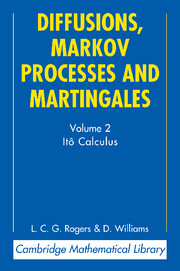CHAPTER IV - INTRODUCTION TO ITÔ CALCULUS
Published online by Cambridge University Press: 05 August 2014
Summary
Here, we give the gist of the ‘martingale and stochastic integral’ method, and illustrate its use via a large number of fully-worked examples. We do not apologize for sometimes advertising the method by showing how it can obtain results which are well known and elementary. Thus, for example, we take the trouble to prove some standard results about the humble Markov chain with finite state-space. But we have also tried to bring into this chapter applications which are less elementary, and which hint at the excitement of the subject today.
TERMINOLOGY AND CONVENTIONS
R-processes and L-processes
We now use the term R-process on [0, ∞) to signify a process all of whose paths are right-continuous on [0, ∞) with limits from the left on (0, ∞). Thus an R-process is what was called in Volume 1 a Skorokhod process, and what is called elsewhere a càdlàg process, or a corlol process, or whatever. An R-function or R-path on [0, ∞) is defined via the obvious analogous definition.
The L-processes on (0, ∞), all of whose paths are left-continuous with limits from the right, will now begin to feature largely in the theory.
Information
- Type
- Chapter
- Information
- Diffusions, Markov Processes and Martingales , pp. 1 - 109Publisher: Cambridge University PressPrint publication year: 2000
Accessibility standard: Unknown
Why this information is here
This section outlines the accessibility features of this content - including support for screen readers, full keyboard navigation and high-contrast display options. This may not be relevant for you.Accessibility Information
- 27
- Cited by
